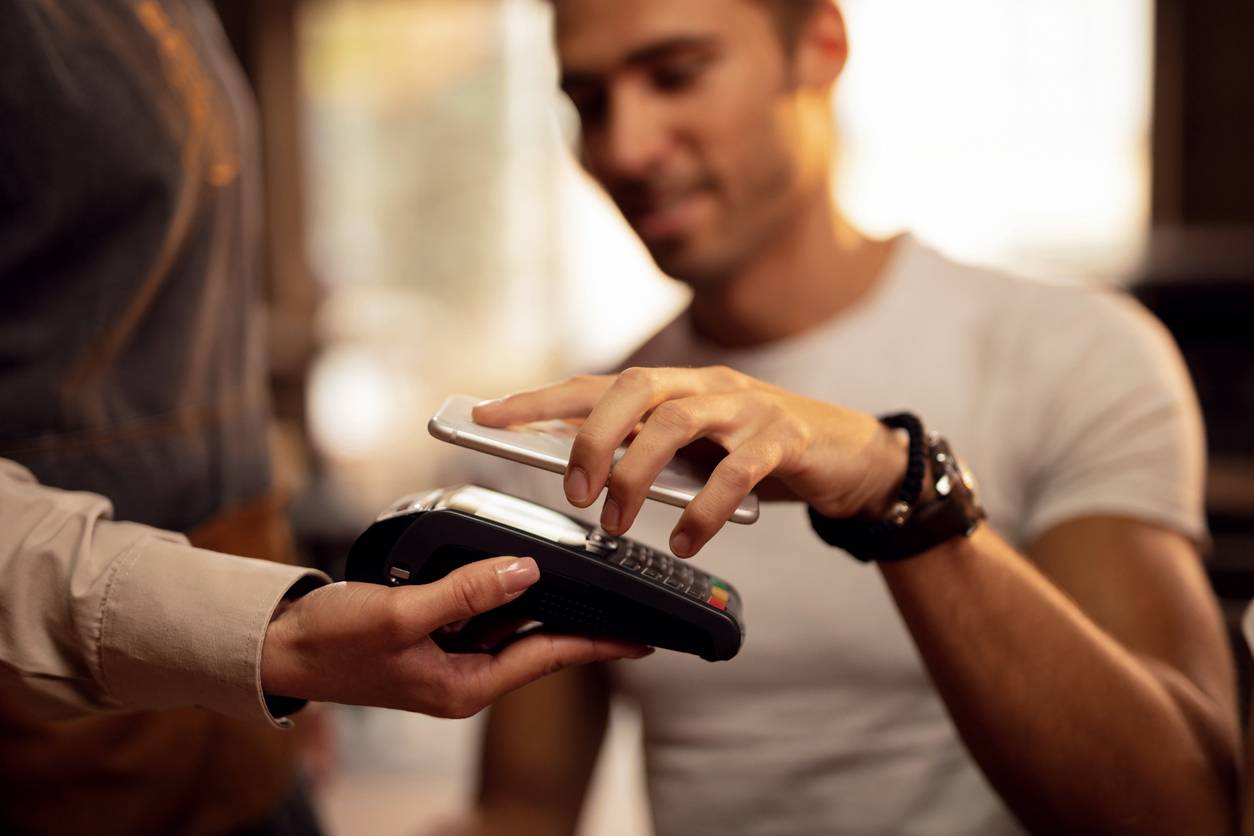Find out the pros and cons of mobile payment and how popular it is in Switzerland.

In Switzerland, mobile payment is becoming increasingly popular. More and more people are using their smartphones to make payments in everyday life. This makes cashless payment easier and faster, which benefits both customers and retailers.
Some of the most well-known mobile payment systems are Apple Pay, Google Pay, Samsung Pay and various banking apps. These systems make it possible to leave your wallet at home and use your smartphone to pay instead. Payments are made contactlessly using Near Field Communication (NFC) technology, which means that the smartphone only needs to be held close to the checkout terminal.
In Switzerland, most POS terminals are already equipped with NFC technology, which makes it easier to use mobile payment systems. There are also providers such as TWINT that enable payment by QR code and can therefore also be used in shops without NFC terminals.
1. Convenience: Mobile payment allows you to pay for purchases or services quickly and conveniently without cash or a credit card. The transaction can be completed with just a few clicks on the smartphone.
2. Speed: Mobile payments are usually faster than traditional payment methods because they are contactless and do not require entering PINs or signatures.
3. Security: Mobile payment is more secure than cash, since personal data and payment information are encrypted and usually not stored directly on the device. In addition, if the smartphone is lost, the mobile payment function can be blocked to prevent unwanted transactions.
4. Inclusion: Mobile payments enable people without a bank account or credit card to participate in digital payments by loading money onto their mobile phone and using it to pay for goods and services.
5. Overview of expenses: Mobile payment applications often provide an overview of transactions made and thus enable better control of one's own spending.
6. Simple application: Mobile payment is easy and intuitive to use as it does not require any additional devices or cards. Most smartphones are already equipped with the required technology.
7. Environmental friendliness: By not using cash or credit cards, you reduce the consumption of resources such as paper and plastic and thus contribute to more environmentally friendly payment transactions.
8. International use: Many mobile payment applications can also be used abroad, which simplifies payment transactions when travelling.
9. Easy money transfers: Mobile payment methods make it easy and quick to send funds to friends or family members.
10. Availability: Mobile payment is available 24/7 and allows transactions outside of bank and shop opening hours.
1. Security concerns: Although mobile payments are typically encrypted, there are still concerns about the security of personal and financial information. Hackers could potentially access sensitive data or install malware on the device to steal payment details.
2. Loss or theft of the device: If the smartphone is lost or stolen, would-be thieves may be able to access the mobile payment app and make fraudulent transactions.
3. Technical problems: Mobile payment systems can sometimes fail due to system errors, network problems or a weak internet connection. This can be inconvenient, especially when relying on mobile payments and don't have an alternative payment method with you.
4. Acceptance by retailers: Not all merchants accept mobile payments, which limits the use of this technology. In some cases, you may still be forced to carry cash or a credit card.
5. Privacy concerns: Mobile payment apps often collect personal information, such as a user's location and shopping history. This data may be shared with third parties or used for targeted advertising, which some users may not want.
6. Battery life: Mobile payments require that the smartphone is switched on and has sufficient battery power. If the battery is empty, mobile payment is no longer possible.
7. Compatibility: Not all smartphones are compatible with all mobile payment systems. Sometimes it is necessary to have a newer device or a specific brand to use mobile payments.
8. Costs: Some mobile payment services charge fees for transactions or require special devices, such as NFC-enabled smartphones, to make payments.
9. Missing need: Many people find mobile payments unnecessary as traditional payment methods such as cash, credit or debit cards are still widely used and accepted.
10. Familiarisation: Some users are simply not used to paying with their mobile phone and therefore continue to prefer traditional payment methods.

Mobile payment is becoming increasingly popular in Switzerland. More and more people are using their smartphones to make contactless and cashless payments for their purchases. Advancing digitization and the spread of smartphones have favoured this development.
However, despite the growth and benefits of mobile payments, there are also security and privacy concerns. Some users are concerned about the storage and protection of their personal and financial information. However, mobile payment service providers are constantly working to improve their security measures and gain customer trust.
Swiss Bankers protects its customers with the help of state-of-the-art security systems. These work 24/7 around the clock and are monitored by experts.
Overall, mobile payment is on the rise in Switzerland, and it can be expected that this development will continue to gain momentum in the coming years. The increasing acceptance of mobile payment services by banks, merchants and consumers shows that mobile payment is playing an increasingly important role in payment transactions.
Mobile payment is more secure than paying in cash. The money can neither be lost nor get into the wrong hands through theft. If the card is lost, it can be blocked by the app in a matter of seconds.
Every 2nd payment is made on a mobile device
No cash, no card, basically you no longer need to take your wallet with you when you go shopping. With mobile payment you can easily pay with your smartphone or smartwatch. The money is debited and transferred directly from the account or the underlying debit, prepaid card or credit card. No wonder this uncomplicated way of paying is becoming more and more popular. The current results of the Swiss Payment Monitor 1/2022 show that every second payment made online (in so-called distance business) is made on a mobile device. In 2019, this share was still around 15%.
In physical stores too, paying by mobile phone is becoming increasingly popular
Mobile payment is also showing an upward trend in face-to-face business, i.e. where the customer is physically standing at a cashier in a shop. From just 1.5% of transactions in 2019, it has quintupled to 7.6% today. Looking at the market as a whole (distance and face-to-face business), mobile payment is in fourth place at 13.3%, behind debit cards (31.8%), cash (30.2%) and credit cards (16.4%).
Usage is also growing steadily among the Swiss population. In a 2019 Statista survey, 13% stated that they made mobile payments at least once a week. In 2021 it was almost 40%.
Boom in mobile payment with the app
Swiss Bankers as pioneers: Mobile payment using an app is no question; the need for contactless payment during the Covid crisis has increased the importance of mobile payment and accelerated its spread. The sales made with payment apps have doubled in each of the last two years.
Swiss Bankers recognized the opportunities and advantages of contactless payment even before the outbreak of the pandemic and relied on this future technology. In July 2016, we introduced mobile payment with Apple Pay as the first company alongside Cornèr Bank. In 2019, Swiss Bankers was the first Swiss company to offer its customers a purely digital credit card in our Swiss Bankers app. Mobile payment is now available for Swiss Bankers customers for all common mobile payment service providers such as Google Pay, Samsung Pay, Fitbit Pay, GarminPay and SwatchPay.
This website uses cookies. By using our website, you agree to the use of cookies. Click here to find out more about the type of cookies this site uses and how to change your setting.